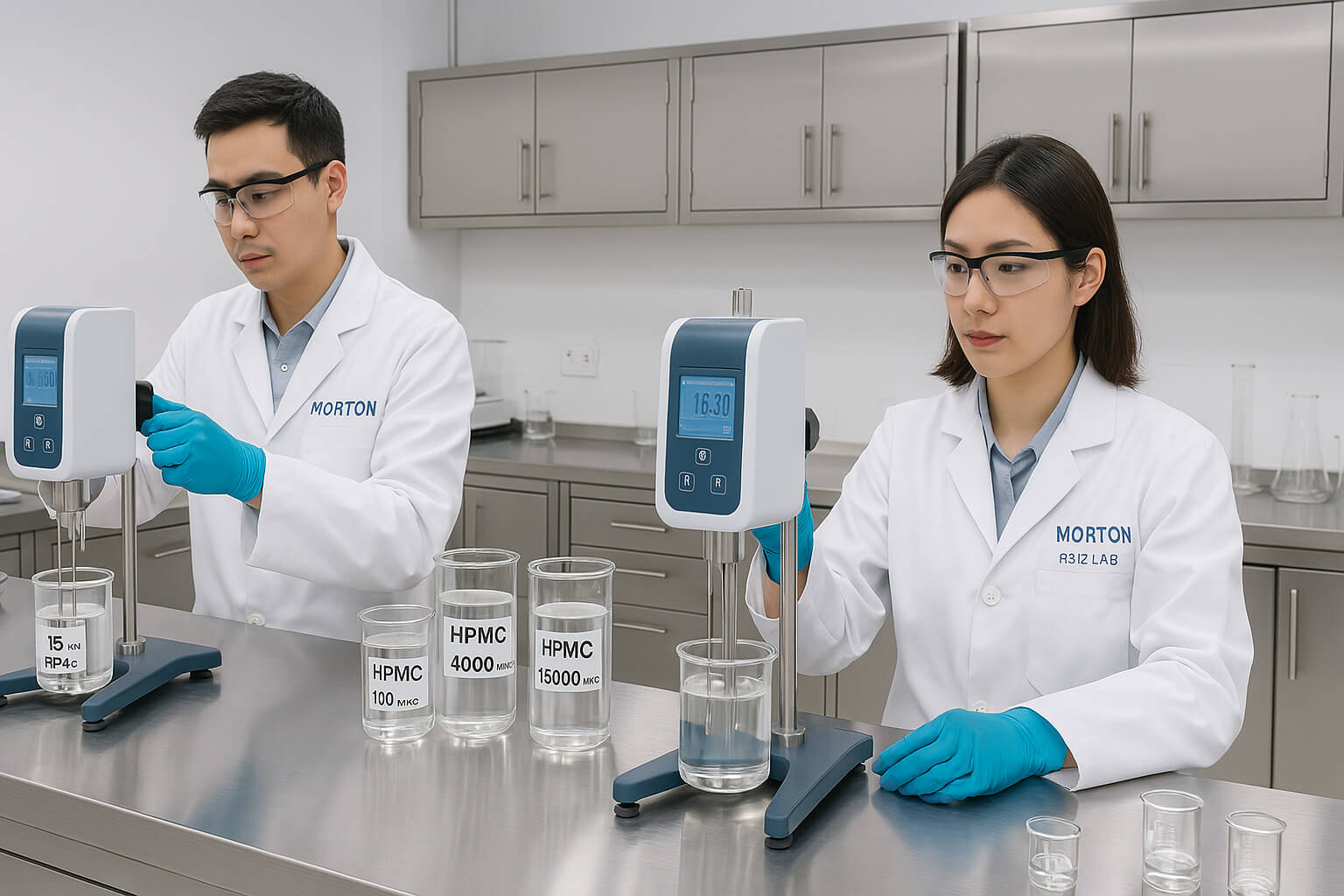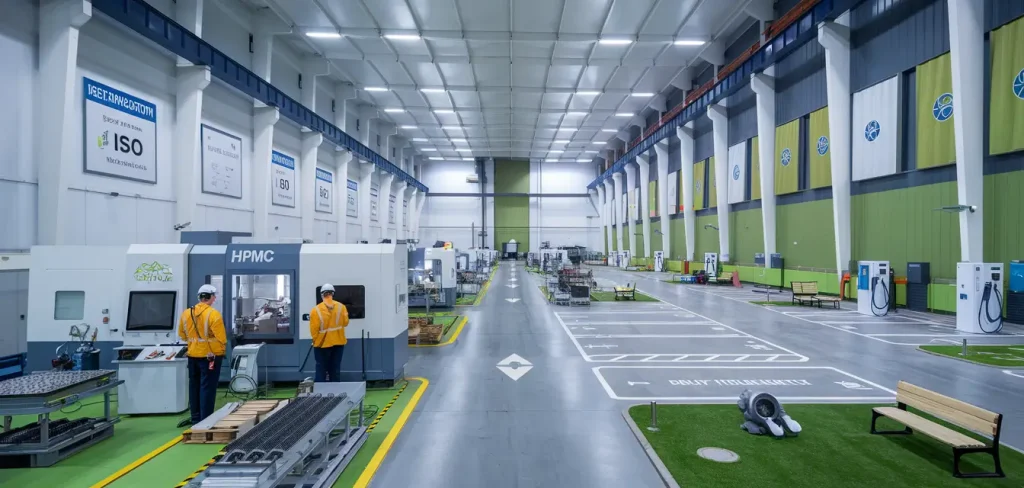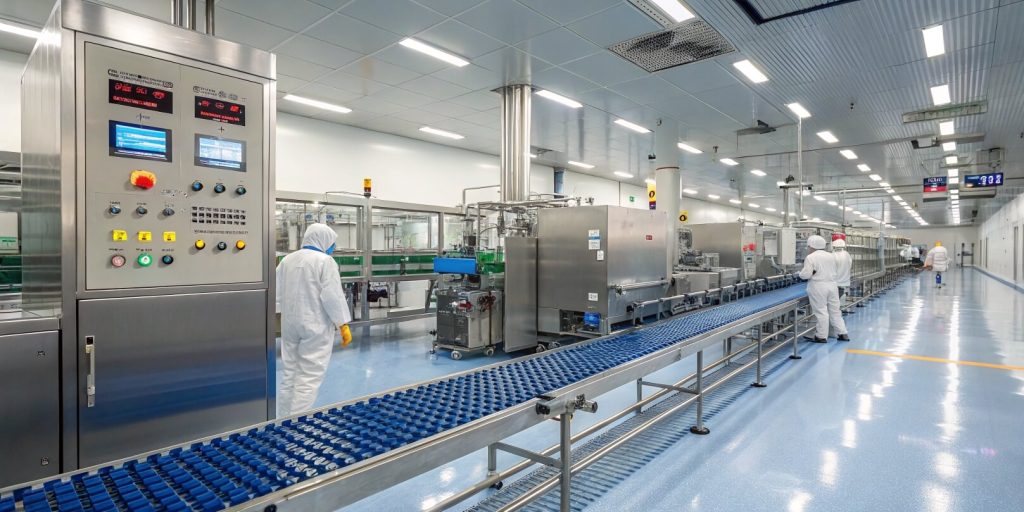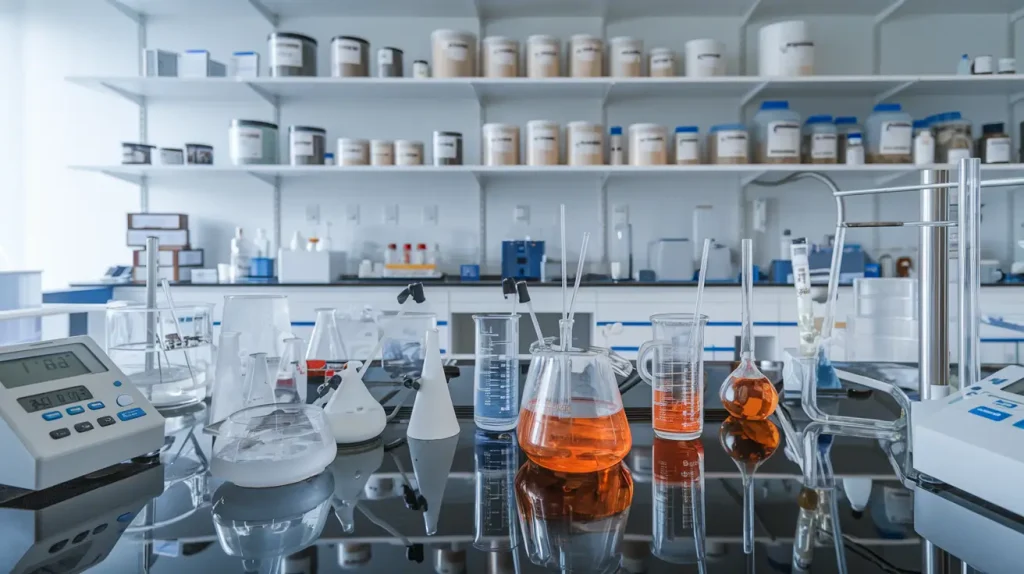Struggling with inconsistent HPMC performance? Your viscosity grade selection might be the hidden culprit affecting your product stability and application results.
Viscosity stands as the most critical parameter when selecting hydroxypropyl methylcellulose for specific applications. This property determines how HPMC flows, mixes, and performs across construction, pharmaceutical, and food applications.

Scientists in our Morton laboratory testing various HPMC viscosity grades using rotational viscometer equipment
Our decade of manufacturing experience shows viscosity impacts everything from workability in construction materials to release profiles in pharmaceuticals. Understanding these factors helps select the optimal grade for your specific requirements.
What is the relationship between HPMC structure and its viscosity grades?
Many customers struggle with unexpected performance variations. The molecular structure of HPMC directly controls its viscosity behavior and application suitability.
HPMC viscosity primarily depends on its molecular weight and substitution pattern. Higher molecular weight produces higher viscosity grades, while substitution type (methoxyl vs. hydroxypropoxyl groups) affects solubility and gelation behavior.
Our production focuses on controlling these molecular characteristics:
- Molecular weight distribution – Higher average molecular weights create higher viscosity grades (K4M vs K100M)
- Degree of substitution (DS) – Affects hydration rate and temperature sensitivity
- Molar substitution (MS) – Changes thermal gelation properties
- Substitution uniformity – Impacts solution clarity and stability
- Chain length distribution – Determines viscosity consistency across batches
When developing custom HPMC for clients, we prioritize structural consistency above all else. Manufacturing precision becomes especially critical for high-viscosity HPMC grades used in extended-release pharmaceuticals, where global standards require tight viscosity tolerances.
The structural features of HPMC create a three-dimensional network when hydrated. This network formation explains why even small variations in molecular weight can dramatically impact final solution viscosity. Through careful control of reaction conditions during production, we achieve precise viscosity ranges from 3 mPa·s to 200,000 mPa·s.
How do production parameters impact HPMC viscosity?
Production inconsistencies can ruin downstream applications. Different manufacturing methods significantly influence HPMC viscosity characteristics and performance stability.
HPMC viscosity can be precisely controlled during manufacturing by adjusting reaction temperature, concentration of reagents, alkalization conditions, and purification methods. These parameters determine the final product's molecular weight distribution and substitution pattern.
Manufacturing Conditions and Viscosity Control
During production, we meticulously control several critical parameters that directly impact viscosity. Temperature management represents the most crucial factor – higher reaction temperatures generally lead to greater chain scission and lower viscosity products. Our factory utilizes advanced temperature monitoring systems that maintain precise control within ±0.5°C throughout the entire reaction vessel.
Alkali concentration similarly affects the final viscosity grade. Higher alkalinity promotes more uniform substitution but can degrade cellulose chains if not properly managed. Our manufacturing process follows industry standards for alkaline treatment while implementing proprietary modifications that optimize viscosity stability.
Reaction time must be precisely controlled to achieve target molecular weights. Longer reactions allow more complete substitution but risk excessive degradation. Our production lines employ automated timing systems coupled with rapid cooling capabilities to halt reactions at exactly the right moment for each viscosity specification.
The degree of substitution affects not only final viscosity but also temperature sensitivity and gelation behavior. Through tight control of methoxyl and hydroxypropoxyl ratios, we produce HPMC that maintains consistent viscosity across varying application conditions.
What external factors can alter HPMC viscosity in application?
Environmental variations often lead to unexpected viscosity changes. Understanding these factors helps maintain consistent performance across different conditions.
HPMC viscosity varies significantly based on concentration, temperature, pH, shear rate, and presence of additives. A 1% solution of high-viscosity HPMC can exhibit 20-80% viscosity reduction when temperature increases from 20°C to 40°C.
Environmental factors impact HPMC viscosity in predictable ways that must be accounted for in formulation:
| Fattore | Effect on Viscosity | Application Consideration |
|---|---|---|
| Temperatura | Decreases with higher temperatures until reaching gelation point | Critical for hot-weather construction applications |
| Concentrazione | Increases exponentially with concentration | Determines water demand in dry-mix mortars |
| pH | Stable from pH 3-11; decreases at extremes | Important for acidic food applications |
| Shear Force | Shows pseudoplastic behavior (thins under shear) | Affects spray application performance |
| Salt/Electrolytes | Generally decreases viscosity | Must be considered in high-salt formulations |
We regularly perform viscosity testing across these variables to help customers anticipate performance in real-world conditions. For construction applications specifically, we recommend accounting for seasonal temperature variations when formulating with HPMC. Our technical team conducts application testing that simulates actual working conditions rather than relying solely on laboratory measurements.
From our experience with global exports, products that perform perfectly in temperate European markets may require viscosity adjustments for Middle Eastern or tropical environments. This environmental sensitivity makes understanding these external factors essential for consistent performance.
How can viscosity be measured and interpreted in HPMC?
Measurement inconsistencies lead to specification confusion. Different viscosity testing methods yield varying results that must be properly interpreted.
HPMC viscosity measurement requires standardized conditions, specified equipment, and proper sample preparation. Results are typically expressed in millipascal-seconds (mPa·s) or centipoise (cP), with testing conducted at 20°C using 2% solutions for most commercial grades.
Standardized Testing Methods
Our quality control laboratory employs multiple viscosity measurement techniques to ensure comprehensive characterization. The most common method uses rotational viscometers with specified spindle types and rotation speeds. This approach aligns with USP and Ph.Eur. standards for pharmaceutical-grade HPMC testing procedures.
For high-precision measurements, especially with pharmaceutical grades, we utilize capillary viscometers that determine intrinsic viscosity. This parameter correlates directly with molecular weight and provides more fundamental characterization than apparent viscosity measurements.
Brookfield viscometers remain the industry standard for HPMC quality control, but rheometers provide more detailed viscosity profiles across different shear rates. This comprehensive testing approach helps predict how HPMC will perform in diverse application scenarios from spray application to extrusion.
Viscosity data interpretation requires understanding the testing conditions. A 2% HPMC solution measured at 20°C with a Brookfield viscometer at 20 RPM serves as the standard reference point across the industry. However, application-specific testing often employs different concentrations or temperatures to simulate actual use conditions.
When reviewing viscosity specifications, always note whether values represent nominal or actual measurements. Our certificates of analysis provide both targeted viscosity ranges and actual measured values to assist with precise formulation work.
How to choose the right HPMC viscosity grade for tile adhesive?
Selecting inappropriate viscosity grades causes adhesive failure. Different tile adhesive applications demand specific HPMC properties for optimal performance.
For tile adhesives, HPMC viscosity selection depends on tile weight, application method, and open time requirements. Medium viscosity grades (15,000-30,000 mPa·s) typically offer the best balance for standard wall tiles, while heavy floor tiles benefit from higher viscosity grades up to 75,000 mPa·s.
From our manufacturing experience, tile adhesive applications require balanced consideration of multiple factors. Wall tile applications demand sufficient sag resistance, which correlates directly with HPMC viscosity. However, extremely high viscosity can impair workability and increase water demand.
We recommend starting with our 4% solution viscosity grades between 20,000-40,000 mPa·s for standard ceramic wall tiles. This range provides adequate water retention while maintaining good workability. For larger format tiles or natural stone, shifting to higher viscosity grades (50,000+ mPa·s) improves adhesion strength and prevents sagging.
Tile adhesives formulated for machine application generally require lower viscosity HPMC (10,000-20,000 mPa·s) to ensure proper pumping and spraying characteristics. These grades maintain water retention while allowing the material to flow through mechanical equipment without clogging.
Climate conditions also influence viscosity selection. In hot, dry environments, higher viscosity grades provide extended open time by improving water retention. Our technical team can recommend specific adjustments based on regional conditions where the adhesive will be used.
Through years of formulation work with global tile adhesive manufacturers, we've observed that viscosity grade selection significantly impacts both application performance and cost-effectiveness. Unnecessarily high viscosity grades increase raw material costs without proportional performance benefits.
What blending and modification techniques affect HPMC viscosity?
Formulators often struggle with viscosity adjustment limitations. Advanced modification techniques offer solutions for fine-tuning performance characteristics.
HPMC viscosity can be customized through blending different grades, combining with complementary cellulose ethers, or chemical modification. These approaches allow formulators to achieve specific rheological profiles not possible with standard grades alone.
Our factory produces custom-blended HPMC products that target precise viscosity specifications. By combining different molecular weight fractions in controlled ratios, we achieve intermediate viscosity grades with improved batch-to-batch consistency. This approach proves particularly valuable for construction applications where slight viscosity variations can significantly impact workability.
Chemical modification techniques, such as controlled oxidation or crosslinking, create specialized HPMC variants with unique viscosity behaviors. These modifications can enhance thixotropy, improve temperature stability, or create delayed-release characteristics for pharmaceutical applications.
For construction applications specifically, we often recommend combining HPMC with complementary cellulose derivatives such as methylcellulose or hydroxyethylcellulose. These combinations provide synergistic rheological profiles that improve water retention while maintaining good workability.
Post-production physical modifications also influence viscosity behavior. Particle size distribution affects dissolution rate and initial viscosity development. Our milling processes can be adjusted to create finer particles for faster dissolution or coarser particles for controlled hydration in specific applications.
Through these blending and modification approaches, we help customers achieve application-specific viscosity profiles that standard catalog grades cannot provide. This customization capability demonstrates why working directly with HPMC manufacturers offers advantages over general distributors who cannot modify base materials.
Domande frequenti
What is the viscosity grade of HPMC?
HPMC viscosity grades typically range from 3 mPa·s to 200,000 mPa·s (measured in 2% solution at 20°C). Commercial grades are often classified using a letter-number system (e.g., K4M, E15) where the letter indicates substitution type and the number relates to approximate viscosity. Standard testing methods from USP and Ph.Eur. ensure consistent grading across manufacturers.
In che modo la temperatura influisce sull'HPMC?
HPMC viscosity decreases as temperature increases until reaching its thermal gelation point (typically 65-85°C depending on substitution). At this critical temperature, HPMC forms a gel structure as hydrophobic interactions between molecules strengthen. This reversible thermal gelation property makes HPMC valuable in applications requiring temperature-responsive behavior, such as sustained-release pharmaceuticals.
What is the viscosity of HPMC K100M and HPMC K15M?
HPMC K100M typically exhibits viscosity of 80,000-120,000 mPa·s (measured in 2% solution at 20°C), while HPMC K15M shows 15,000-25,000 mPa·s under identical conditions. Both grades feature high hydroxypropoxy content (7-12%) with 19-24% methoxyl substitution. K100M's significantly higher molecular weight makes it preferred for extended-release pharmaceutical applications requiring robust gel formation.
Qual è la differenza tra HPMC E5 ed E15?
HPMC E5 has viscosity of 4-6 mPa·s while E15 measures 15-20 mPa·s (both in 2% solution at 20°C). Besides viscosity, both share similar chemical substitution patterns with 28-30% methoxyl and 7-12% hydroxypropoxyl content. E5's lower molecular weight makes it preferred for surface sizing and coating applications, while E15 provides better binding strength in tablet formulations due to its higher viscosity.
Conclusione
Viscosity stands as the defining characteristic of HPMC that directly impacts performance across applications. From our decade of manufacturing experience, we've observed that understanding molecular structure, production parameters, environmental factors, and measurement methods remains essential for successful HPMC application.
For optimal results in your specific application, consider both the nominal viscosity grade and how it behaves under your actual processing conditions. The right HPMC viscosity selection balances workability, water retention, adhesion strength, and cost-effectiveness.
Contact Morton for customized HPMC viscosity recommendations tailored to your specific application requirements. Our technical team can help identify the optimal grade or develop custom blends that deliver consistent performance for your products.




